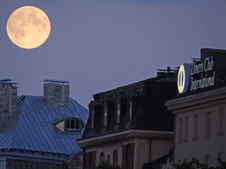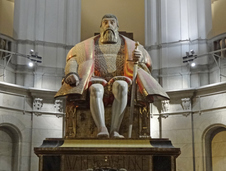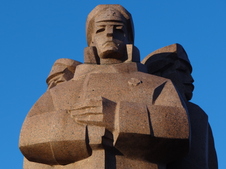 | 16.
Uzbekistan 2013 (October 2013)Uzbekistan - situated in the heart of Central Asia - is a land that has been conquered and reconquered again and again. Alexander the Great, Genghis Khan, Tamerlane (Timur) are among its most notable warrior/rulers. There have been others. Countless others.
Once we landed in country's shiny, modern capital - Tashkent -and traded in our dollars for a suitcase full of soms, we were ready to tackle Uzbekistan's Silk Road. First stop, Samarkand - conquerer/hero Tamerlane's home base. Although the Registan and Shah-I Zinda are its star attractions, the city's sprawling central market is a close second.
From Samarkand we detoured into the Nurata mountains for a one-night homestay, then spent another night nestled down in a yurt camp near Lake Aydarkul before we final settled in for a few nights in Bukhara. At Bukhara's heart is one of the Silk Road's fabled ancient walled cities. Mosques, mausoleums and minarets dominate the skyline. Fabled rugs, clothing and weavings fill its shops.
From Bukhara we traveled further north to Khiva - a walled city that has been turned into a living museum. Our days were spent exploring the crumbling desert forts in the Karakalpakstan region (spreading out from Khiva's northeast) and venturing further northwest to the remote city of Nukus and the Igor Savitsky Museum. During the Khiva's moonlit nights, we wandered its ancient streets or took in outdoor screenings of classis Uzbek flims.
When we returned to Tashkent and prepared to leave, we realized that we came to Uzbekistan for its legendary Silk Road cities but we what we will remember most is the warmth and hospitality its people. |
| 2725 Visits
135 Images
Gallery Album | |
|
 | 17.
Northern Chile 2012 (August 2012)Why spend two weeks in Chile's Atacama Desert - known as having the driest climate on Earth? Maybe to behold otherworldly scenery in one of the most remote locations on the continent; or perhaps to gaze up into the clearest night skies on the planet; or simply to revel in one perfectly warm, perpetually sunny day after another.
We began our tour of the north in the coastal town of La Serena, took a side trip into the beautiful Elqui Valley, flew up to San Pedro de Atacama and then bused back to the coast and the town of Arica. A few days were lost wandering up to Parque Lauca before we spent our final nights in Santiago, Chile's capital city.
A night at one of the observatories in the Elqui Valley is a requirement and the San Pedro reqion is a deserved tourist magnet. But desolate Parque Lauca is a treasure worth discovering - the ultimate destination for any explorer of Chile's austere northern region.
Get all the details of this trip on our blog: Northern Chile Blog |
| 4644 Visits
106 Images
Gallery Album | |
|
 | 18.
Chiapas, Mexico 2012 (April 2012)In 1995, we spent only three nights in San Cristóbal de Las Casas but it has lingered in our travel memory for years. This colonial mountain town cast its spell on us. We vowed to return.
Seventeen years later and we are back. San Cristóbal has changed - more restaurants, shops and walking streets – but its appeal remains.
We revisited San Juan Chamula and Zinacantán – just two of the many traditional Mayan villages that surround San Cristóbal. But now we had more time to explore Chiapas' outlying regions. Once again, we traveled - via the "road to hell” (See our blog - link below)- to Palenque; journeyed along the Guatemalan border to behold the Mayan ruins at Yaxchilán and Bonampak; stopped off at Agua Azul and Misol-Há on our way back to San Cristóbal (again on the "road to hell, part 2”); and finally headed south to spend a few nights in the colonial town of Comitán, and visit the nearby Lagunas de Montebello and El Chiflón.
Even after twelve days, we wanted more. The State of Chiapas is still off the radar of many international travelers. Mexican tourists, though, are descending upon this region in record numbers: to soak up its culture, history and natural beauty.
Again, we vow to return. We just hope it doesn’t take another seventeen years for it to happen.
(For more detailed information on this trip - including hotel and restaurant recommendations, transportation information and the nitty-gritty of the costs of travel - check out our blog at: Chiapas Blog) |
| 4024 Visits
105 Images
Gallery Album | |
|
 | 19.
Helsinki Finland (August 2011)On a sunny August day, it is hard to resist allure of this Scandinavian capital. Canopied food stalls cram its waterfront; street-corner stands overflow with an astonishing array of late summer berries; joggers, bicyclists and cafe idlers glory in the protracted Finnish summer sun.
Helsinki. Stylish and sophisticated. The hub of the country. Its largest city. Yet with a surprisingly small-town feel.
During our nearly three weeks in the Baltic region, we zig-zagged back and forth to and from Helsinki. It became our base: more comfortable and comforting with each return. An under-rated gem on the Baltic. |
| 3282 Visits
57 Images
Gallery Album | |
|
 | 20.
St Petersburg Russia (August 2011)The "Venice of the Baltic". Peter the Great's greatest achievement, his "Window on the West". The city was christened St. Petersburg, reborn as Petrograd, renamed Leningrad and is now back to being St. Petersburg once again.
St. Petersburg began life as the Tsarist capital. It survived an attenuated seige during World War II. But it is now being invaded once again - this time by hordes of tourists. Packs of them. And always accompanied by linguistically gifted, flag-toting guides. Independent tourists have to devise their own strategies to combat the group tours - especially in summer. It is possible, but requires planning.
Unfortunately, August can also harbor some of the rainiest days of the year. During our stay, clouds and rain crowded out most glimpses of the sun. Nevertheless, the town still gleamed. The Hermitage and Russian Museums garnered the usual awe. And downing a few blinys and shots of vodka helped ease any feelings of dreariness. |
| 2603 Visits
39 Images
Gallery Album | |
|
 | 21.
Stockholm Sweden (August 2011)With only three nights and four days to spend in Stockholm, it was only possible for us to get a tantalizing taste of what this city has to offer. Gamla Stan, the oldest and most picturesque neighborhood in the city, oozes medieval charm. It is the heart of Stockholm. The place to be.
Yes, the Vasa and Nordic Museums are must-sees; and a trip out to Drottningham Palace is predictably impressive. But in summer, the real pleasures of Stockholm are to found by wandering its streets. Street fairs, open-air markets and free concerts are commonplace on most summer weekends. And we took advantage of them all.
But we saved the best for last: a boat trip through Stockholm's archipelago - over 30,000 islands extending 80 miles out into the Baltic Sea. No mere daytrip for us - it was our over-night transport from Sweden to Riga, Latvia. |
| 2730 Visits
42 Images
Gallery Album | |
|
 | 22.
Riga Latvia & Tallinn Estonia (August 2011)After enjoying the sophisticated pleasures of Helsinki, the imposing majesty of St. Petersburg and the medieval beauty of Stockholm, how could Riga and Tallinn possibly compete? They do. And nearly outshine their more reknown neighbors.
Riga is a beauty. Just a few steps inward from the Baltic Sea, Riga's medieval spires soar above the shores of the Daugava River. Its more recent neighborhoods spill eastward. The city is home to one of the largest collection of Art Nouveau-styled buildings in Europe. It is also has a surprisingly respectable National Art Museum and a movingly informative Latvian War Musuem.
Tallinn, at first, seems a little too well-preserved (a little "Disneyesque") and touristically accommodating ("well-worn, cruise ship port-of-call") to feel genuine. But how can Estonians be faulted for getting the "tourist thing" so right when they possess such an extraordinary medieval treasure.
But don't misunderstand: neither of these cities are simply outdoor medieval museums. They are both on the vanguard of our technological age. Estonia and Latvia are galloping forward - at an economic pace greater than many of their larger Baltic rivals. Their futures may become even more interesting than their pasts. Just maybe not as beautiful. |
| 2363 Visits
39 Images
Gallery Album | |
|
 | 23.
Morocco (April 2011)How can you see the highlights of this country in only 10 days without renting a car or enduring a tour bus? And without breaking your travel budget? Simple. Go by train. It is one of Morocco's best kept travel secrets.
Just step off your plane in Casablanca, descend a set of escalators (within the airport) and hop on a train. Easy. And you're on your way. The trains are clean, efficient and affordable.
From Casablanca's airport, we first traveled by train to Marrakesh - spent three nights - then headed off for a 2-night stay in Moulay Idriss/Volubilis (via the train to Meknes and a shared taxi to Moulay Idriss), then on to Fes (by train from Meknes) for three nights and finally our last day/night in Rabat (by train from Fes) before arriving in Casablanca(from Rabat by train) to catch our homeward-bound plane.
Add on side trips if you have more time; subtract a destination if time is tight. Either way, train travel in Morocco is a no-brainer. A winning strategy for newbies or veteran world wanderers. |
| 3418 Visits
112 Images
Gallery Album | |
|
 | 24.
Peru 2010 (August/September 2010)Three weeks of travel in Peru - more off than on the Gringo Trail. Just the way we like it.
We began by skimming along the Pacific coastline. Starting in the north - in Chiclayo and Trujillo - we worked our way south to Paracas and the Ballestas Islands. Then, weaving our way inland, we drifted into the oasis town of Huacachina before flying off to view the nearby Nasca Lines.
But the mountain towns were not to be neglected. The colonial towns of Cajamarca and Ayacucho were standouts. But Huaraz and Chavin - cradled by picture-postcard, mountain scenery - demanded bundles of days for high-altitude Andes exploration.
These desert and mountain regions of Peru should be on every independent travelers "must see" list - before the strangle of tourism takes hold. And it will. The archeological treasures of the north coast, the stunning desert vistas of Huacachina and the barren beauty of the Paracas coast are fated to emerge as world-class destinations. Trust us. Word is already out. |
| 4313 Visits
156 Images
Gallery Album | |
|
 | 25.
Guatemala Semana Santa 2010 (March/April 2010)We kicked off our Guatemalan Easter Week in Santiago Atitlan, along the shores of Lake Atitlan. The town is also the home of the venerated statue of Maximon: an indigenous, fictional half-breed - part Judas, part Spanish conquistador. On the Monday evening following Palm Sunday, we watched - along with the the women and children of the village - the men wash Maximon's clothes in the lake's waters.
After laundry night, we sped back to Antigua for the main attraction - one of the most lavish Holy Week celebrations in all of Central America. Each day during Semana Santa, procession participants - carrying giant apparitions of suffering Christs and weeping Marys - trudge for hours along the city's sawdust- and flower-carpeted streets. The Lenten activities culminate with the largest and most somber procession on Good Friday evening.
But for us, the high point (figuratively and literally) of the week was the long-anticipated hike up Pacaya Volcano. Pacaya is one of the few active volcanoes that can be climbed. It is a dangerous and potentially lethal ascent: fascinating, nightmarish - like walking over hell. And we have the melted shoes to prove it. |
| 4806 Visits
100 Images
Gallery Album | |
|
 | 26.
Nicaragua (April 2009)The Spanish may have conquered it, the Somozas may have ruled it but its forty volcanoes continue to dominate it. Nicaragua is a marvelous Central American amalgam of natural wonders, colonial splendors and political survival.
Skipping Managua entirely, we made a beeline for the colonial city of Leon. Catching the last few days of its Semana Santa (Holy Week) festivities, we often found ourselves ambushed by one of Leon's many neighborhood religious processions. But the highlight was watching the day-long creation of the Good Friday sawdust "carpets" (alfombras). Thoroughly capitvating. Heady political murals and dozens of colonial churches added to the conversation in this intellectually-charged, university town.
Granada, our next stop, is Nicaragua’s other, more restored colonial city. Yes, it is more "gringoized" than Leon but it is a beautiful, comfortable and convenient base for exploring nearby attractions. For example, from Granada, with Lake Nicaragua lapping at its shores, Isla Ometepe, the lake’s mythic twin volcano island, is an easy and essential excursion.
But the no trip would be complete without checking out conditions at Volcan Masaya. A night time tour is the most dramatic. Just remain calm and “duck and cover” under a nearby car if the volcano decides to spew a few rocks in your direction. Remember, you were warned. |
| 3899 Visits
80 Images
Gallery Album | |
|
 | 27.
Guatemala 2008 (August 2008)Fourteen years and one civil war have passed since our first visit to Guatemala.
Antigua is still one of the most beautiful towns in all of Latin America. Its magnificent volcano-ringed setting transforms even the most hapless of snapshots into one with National Geographic possibilities. McDonalds and tuk-tuks may have invaded the town but its earthquake-tossed colonial heart remains unscathed. Chichicastenango and the Highlands - the most traditional regions of the country - are still struggling to move forward while clutching the past. And Lake Atitlan. Ah, Lake Atitlan - where you could lose your entire vacation and not even care.
Guatemala's natural beauty continues to astonish. Its indigenous culture survives despite the inevitable encroachment of the 21st century. But in our minds, it will always be the most fascinating and diverse country in Central America. |
| 3109 Visits
40 Images
Gallery Album | |
|
 | 28.
Puebla & Veracruz States, Mexico 2008 (April 2008)On this trip we purposely veered off the Mexican “gringo trail” to explore some of Mexico’s least visited but most worthwhile sights and cities.
Landing in the small but friendly airport on the outskirts of Puebla, we spent our first two nights in the university town of Cholula. From there we journeyed (by public bus, always) to Xalapa before side-stepping over to the port city of Veracruz. We then hugged the Gulf coastline on our way to Papantla, tumbled through mountain shortcuts to the indigenous village of Cuetzalan and finally zig-zagged our way back to Puebla for a final night’s rest.
What were the highlights? The pure tourist in us reveled at wandering through Puebla’s bustling Sunday markets, then delighted in discovering an "untouristy" outdoor danzon performance at a plazuela in Veracruz. The amateur archeologist in us crooned while counting niches at El Tajin, then cursed while ducking through tunnels beneath the Gran Piramide of Cholula. But the traveler in us will never forget watching the waves of fog lap in and out of Cuetzalan’s main square each evening - confirming the town's appellation as a "pueblo magico".
If you can do without white-sand beaches, can speak a little Spanish and can endure some twisty mountain bus rides, this journey will reveal a side of Mexico that few North Americans see. Fascinating ruins, indigenous mountain towns and grand colonial cities await – and all amazingly without hordes of tourists. |
| 17268 Visits
83 Images
Gallery Album | |
|
 | 29.
Yangon, Myanmar (July 2007)Yangon (formerly Rangoon), the capital of Myanmar (formerly Burma), appears to be crumbling before your eyes. Time stopped decades ago for this city of four million. It is the Havana of Southeast Asia.
Thankfully, Yangon has at least one beautifully maintained structure - Shwedegon Pagoda - one of the most important and imposing Buddhist shrines in the world. Shwedagon is reason enough to linger.
Heat and humidity conspire to defeat even the most enthusiastic of tourists in Yangon. Yet, even as reservoirs of perspiration pool in your shoes, you can't help being drawn into the charms of this time-warped town. |
| 4078 Visits
19 Images
Gallery Album | |
|
 | 30.
Bagan, Myanmar (July 2007)Bagan - Myanmar's premiere archeological destination - streams out over 25 square miles and contains an astonishing array of more than 2,000 temples.
Not as well known as Cambodia's Angkor Wat but every bit as impressive. There is nothing like surveying the Bagan plain from a temple-top perch at twilight. Nothing. The setting sun plants chiaroscuristic kisses on all buildings within its reach. Beautiful and calming.
Unfortunately, Myanmar's military government is in the process of creating replicas of many of the temples atop unexcavated ruins. (Their idea of "restoration".) The result is a Disneyfication (pretty, but characterless) of these historic gems. Go before more irreparable damage is done. |
| 7535 Visits
46 Images
Gallery Album | |
| |